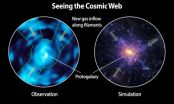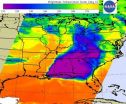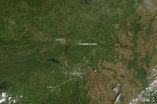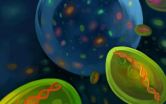(Press-News.org) Caltech astronomers have taken unprecedented images of the intergalactic medium (IGM)—the diffuse gas that connects galaxies throughout the universe—with the Cosmic Web Imager, an instrument designed and built at Caltech. Until now, the structure of the IGM has mostly been a matter for theoretical speculation. However, with observations from the Cosmic Web Imager, deployed on the Hale 200-inch telescope at Palomar Observatory, astronomers are obtaining our first three-dimensional pictures of the IGM. The Cosmic Web Imager will make possible a new understanding of galactic and intergalactic dynamics, and it has already detected one possible spiral-galaxy-in-the-making that is three times the size of our Milky Way.
The Cosmic Web Imager was conceived and developed by Caltech professor of physics Christopher Martin. "I've been thinking about the intergalactic medium since I was a graduate student," says Martin. "Not only does it comprise most of the normal matter in the universe, it is also the medium in which galaxies form and grow."
Since the late 1980s and early 1990s, theoreticians have predicted that primordial gas from the Big Bang is not spread uniformly throughout space, but is instead distributed in channels that span galaxies and flow between them. This "cosmic web"—the IGM—is a network of smaller and larger filaments crisscrossing one another across the vastness of space and back through time to an era when galaxies were first forming and stars were being produced at a rapid rate.
Martin describes the diffuse gas of the IGM as "dim matter," to distinguish it from the bright matter of stars and galaxies, and the dark matter and energy that compose most of the universe. Though you might not think so on a bright sunny day or even a starlit night, fully 96 percent of the mass and energy in the universe is dark energy and dark matter (first inferred by Caltech's Fritz Zwicky in the 1930s), whose existence we know of only due to its effects on the remaining 4 percent that we can see: normal matter. Of this 4 percent that is normal matter, only one-quarter is made up of stars and galaxies, the bright objects that light our night sky. The remainder, which amounts to only about 3 percent of everything in the universe, is the IGM.
As Martin's name for the IGM suggests, "dim matter" is hard to see. Prior to the development of the Cosmic Web Imager, the IGM was observed primarily via foreground absorption of light—indicating the presence of matter—occurring between Earth and a distant object such as a quasar (the nucleus of a young galaxy).
"When you look at the gas between us and a quasar, you have only one line of sight," explains Martin. "You know that there's some gas farther away, there's some gas closer in, and there's some gas in the middle, but there's no information about how that gas is distributed across three dimensions."
Matt Matuszewski, a former graduate student at Caltech who helped to build the Cosmic Web Imager and is now an instrument scientist at Caltech, likens this line-of-sight view to observing a complex cityscape through a few narrow slits in a wall: "All you would know is that there is some concrete, windows, metal, pavement, maybe an occasional flash of color. Only by opening the slit can you see that there are buildings and skyscrapers and roads and bridges and cars and people walking the streets. Only by taking a picture can you understand how all these components fit together, and know that you are looking at a city."
Martin and his team have now seen the first glimpse of the city of dim matter. It is not full of skyscrapers and bridges, but it is both visually and scientifically exciting.
The first cosmic filaments observed by the Cosmic Web Imager are in the vicinity of two very bright objects: a quasar labeled QSO 1549+19 and a so-called Lyman alpha blob in an emerging galaxy cluster known as SSA22. These objects were chosen by Martin for initial observations because they are bright, lighting up the surrounding IGM and boosting its detectable signal.
Observations show a narrow filament, one million light-years long, flowing into the quasar, perhaps fueling the growth of the galaxy that hosts the quasar. Meanwhile, there are three filaments surrounding the Lyman alpha blob, with a measured spin that shows that the gas from these filaments is flowing into the blob and affecting its dynamics.
The Cosmic Web Imager is a spectrographic imager, taking pictures at many different wavelengths simultaneously. This is a powerful technique for investigating astronomical objects, as it makes it possible to not only see these objects but to learn about their composition, mass, and velocity. Under the conditions expected for cosmic web filaments, hydrogen is the dominant element and emits light at a specific ultraviolet wavelength called Lyman alpha. Earth's atmosphere blocks light at ultraviolet wavelengths, so one needs to be outside Earth's atmosphere, observing from a satellite or a high-altitude balloon, to observe the Lyman alpha signal.
However, if the Lyman alpha emission lies much further away from us—that is, it comes to us from an earlier time in the universe—then it arrives at a longer wavelength (a phenomenon known as redshifting). This brings the Lyman alpha signal into the visible spectrum such that it can pass through the atmosphere and be detected by ground-based telescopes like the Cosmic Web Imager.
The objects the Cosmic Web Imager has observed date to approximately 2 billion years after the Big Bang, a time of rapid star formation in galaxies. "In the case of the Lyman alpha blob," says Martin, "I think we're looking at a giant protogalactic disk. It's almost 300,000 light-years in diameter, three times the size of the Milky Way."
The Cosmic Web Imager was funded by grants from the NSF and Caltech. Having successfully deployed the instrument at the Palomar Observatory, Martin's group is now developing a more sensitive and versatile version of the Cosmic Web Imager for use at the W. M. Keck Observatory atop Mauna Kea in Hawaii. "The gaseous filaments and structures we see around the quasar and the Lyman alpha blob are unusually bright. Our goal is to eventually be able to see the average intergalactic medium everywhere. It's harder, but we'll get there," says Martin.
Plans are also under way for observations of the IGM from a telescope aboard a high-altitude balloon, FIREBALL (Faint Intergalactic Redshifted Emission Balloon); and from a satellite, ISTOS (Imaging Spectroscopic Telescope for Origins Surveys). By virtue of bypassing most, if not all, of our atmosphere, both instruments will enable observations of Lyman alpha emission—and therefore the IGM—that are closer to us; that is, that are from more recent epochs of the universe.
Two papers describing the initial data from the Cosmic Web Imager have been published in the Astrophysical Journal: "Intergalactic Medium Observations with the Cosmic Web Imager: I. The Circum-QSO Medium of QSO 1549+19, and Evidence for a Filamentary Gas Inflow" and "Intergalactic Medium Observations with the Cosmic Web Imager: II. Discovery of Extended, Kinematically-linked Emission around SSA22 Lyα Blob 2." The Cosmic Web Imager was built principally by three Caltech graduate students—the late Daphne Chang, Matuszewski, and Shahinur Rahman—and by Caltech principal research scientist Patrick Morrissey, who are all coauthors on the papers. Additional coauthors are Christopher Martin, Anna Moore, Charles Steidel, and Yuichi Matsuda.
INFORMATION:
The intergalactic medium unveiled: Caltech's Cosmic Web Imager
2014-04-30
ELSE PRESS RELEASES FROM THIS DATE:
Stem cells aid heart regeneration in salamanders
2014-04-29
SAN DIEGO (April 29, 2014) – Imagine filling a hole in your heart by regrowing the tissue. While that possibility is still being explored in people, it is a reality in salamanders. A recent discovery that newt hearts can regenerate may pave the way to new therapies in people who need to have damaged tissue replaced with healthy tissue.
Heart disease is the leading cause of deaths in the United States. Preventative measures like healthful diets and lifestyles help ward off heart problems, but if heart damage does occur, sophisticated treatments and surgical procedures ...
Study confirms increased prevalence of GI symptoms among children with autism
2014-04-29
A new study conducted by researchers at Marcus Autism Center, Children's Healthcare of Atlanta and Emory University School of Medicine indicates that children with autism spectrum disorder (ASD) are more than four times more likely to experience general gastrointestinal (GI) complaints compared with peers, are more than three times as prone to experience constipation and diarrhea than peers, and complain twice as much about abdominal pain compared to peers.
The results were reported in the April 28, 2014, online early edition of the journal Pediatrics.
While parents ...
NASA satellite sees colder temperatures at tops of severe weather thunderstorms
2014-04-29
The weather system that dropped tornadoes in seven central and southern U.S. states on April 27-28, moved east and generated more tornadoes on April 29. NASA's Aqua satellite gathered temperature data on the thunderstorm cloud tops in the system and found them to be higher in the atmosphere and colder. The tornado outbreak over the evening and overnight hours of April 28-29 is thought to have generated more tornadoes in northern Mississippi and Alabama.
NASA's Aqua satellite passed over the eastern U.S. early in the morning on April 29 at 07:41 UTC/3:41 a.m. EDT and gathered ...
Search for extraterrestrial life more difficult than thought
2014-04-29
A new study from the University of Toronto Scarborough suggests the search for life on planets outside our solar system may be more difficult than previously thought.
The study, authored by a team of international researchers led by UTSC Assistant Professor Hanno Rein from the Department of Physical and Environmental Science, finds the method used to detect biosignatures on such planets, known as exoplanets, can produce a false positive result.
The presence of multiple chemicals such as methane and oxygen in an exoplanet's atmosphere is considered an example of a ...
NASA satellite spots tornado track near Conway, Ark.
2014-04-29
A violent tornado touched down in Arkansas on April 27, 2014, killing as many as 15 people. The top image, acquired on April 28 by the Moderate Resolution Imaging Spectroradiometer (MODIS) on NASA's Aqua satellite, shows what appears to be a tornado track north of Little Rock, Arkansas. The lower image, from April 25, shows the same area before the storm. The tracks are pale brown trails where trees and plants have been uprooted, leaving disturbed ground.
The difference in clarity between the two images is likely due to the centering of the scene beneath the satellite. ...
Preliminary results show improvement in MS symptoms
2014-04-29
Combining the estrogen hormone estriol with Copaxone, a drug indicated for the treatment of patients with relapsing forms of multiple sclerosis (MS), may improve symptoms in patients with the disorder, according to preliminary results from a clinical study of 158 patients with relapsing remitting multiple sclerosis (RRMS). The findings were presented today by Rhonda Voskuhl, M.D., from the University of California, Los Angeles, at the American Academy of Neurology Annual Meeting in Philadelphia. The study was funded by the National Institute of Neurological Disorders and ...
Octillions of microbes in the seas: Ocean microbes show incredible genetic diversity
2014-04-29
The smallest, most abundant marine microbe, Prochlorococcus, is a photosynthetic bacterial species essential to the marine ecosystem.
It's estimated that billions of the single-celled creatures live in the oceans, forming the center of the marine food web.
They occupy a range of ecological niches based on temperature, light, water chemistry and interactions with other species.
But the diversity within this single species remains a puzzle.
To probe this question, scientists at the Massachusetts Institute of Technology (MIT) recently performed a cell-by-cell genomic ...
Consuming high-protein breakfasts helps women maintain glucose control, MU study finds
2014-04-29
COLUMBIA, Mo. – In healthy individuals, the amount of glucose, or sugar, in the blood increases after eating. When glucose increases, levels of insulin increase to carry the glucose to the rest of the body. Previous research has shown that extreme increases in glucose and insulin in the blood can lead to poor glucose control and increase an individual's risk of developing diabetes over time. Now, a University of Missouri researcher has found that when women consumed high-protein breakfasts, they maintained better glucose and insulin control than they did with lower-protein ...
New data suggest potassium & dietary fiber intake among toddlers should be priority
2014-04-29
(SAN DIEGO, CA) April 29, 2014 – Recommendations to increase the intake of potassium and dietary fiber among young children should be a priority for the 2020 Dietary Guidelines for Americans, according to a new study by the Alliance for Potato Research and Education (APRE) presented today at Experimental Biology 2014.
While the federal Dietary Guidelines has focused on adults and children 2 years of age and older, the 2020 Dietary Guidelines will include Americans of all ages, starting from birth, noted Maureen Storey, PhD, co-author of the study and APRE president and ...
Two-part special issue of Ergonomics in Design highlights climate change
2014-04-29
Human factors/ergonomics (HF/E) experts, like professionals in many other scientific domains, have joined the fight against global warming and climate change. Their research and practice focus on finding ways to combat or minimize its serious effects.
A special two-part issue of Ergonomics in Design examines how HF/E professionals can continue working to mitigate this worldwide phenomenon. Part 1 of the special issue, guest edited by Ken Nemire, is now available online and may be found at http://erg.sagepub.com/.
"With recent research indicating we stay close to ...




